Analysis of Ryanair's Low-Fare Strategy: A Microeconomic Perspective
VerifiedAdded on 2022/12/26
|9
|2197
|32
Report
AI Summary
This report provides a microeconomic analysis of the challenges faced by Ryanair, a prominent airline company, focusing on the period around 2018 and 2019 when the industry experienced a cycle of low fares and declining profits. The report examines the situation through the lens of microeconomic concepts, specifically supply and demand, and cost and profit analysis. It begins by referencing a BBC news article highlighting the concerns of Ryanair's CEO regarding the impact of low fares on the company's profitability. The analysis explores how changing consumer preferences and a competitive business environment contributed to a leftward shift in the demand curve, forcing Ryanair to lower prices to maintain market share. The report then delves into the supply side, discussing how the rightward shift of the supply curve further influenced prices and profitability. The report also discusses the impact of costs, including fuel, maintenance, and employee compensation, on Ryanair's profit margins, and the role of profits in business survival. The conclusion emphasizes the detrimental impact of continuous fare declines on airline companies and the need for interventions from both the government and industry players to address these issues.
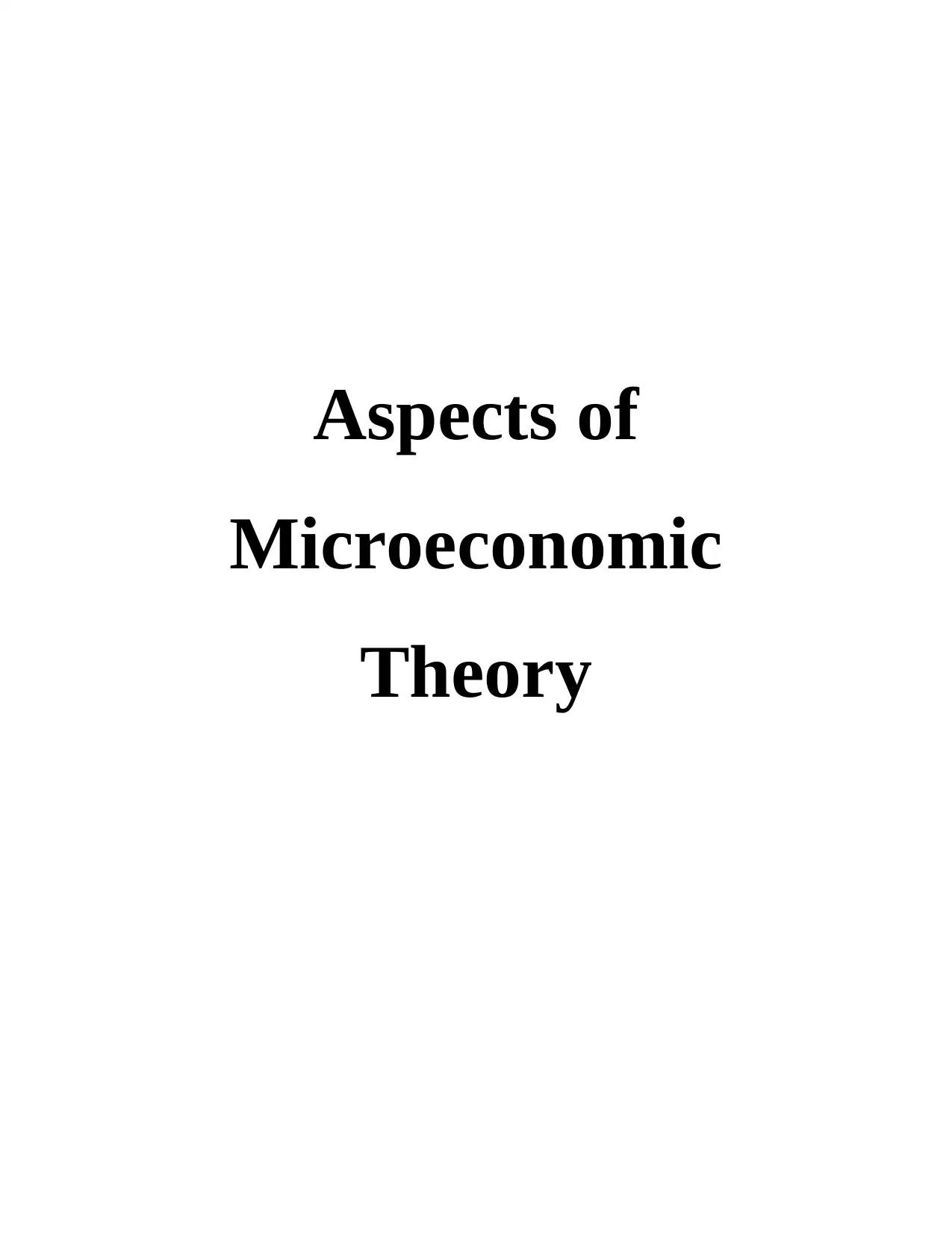
Aspects of
Microeconomic
Theory
Microeconomic
Theory
Paraphrase This Document
Need a fresh take? Get an instant paraphrase of this document with our AI Paraphraser
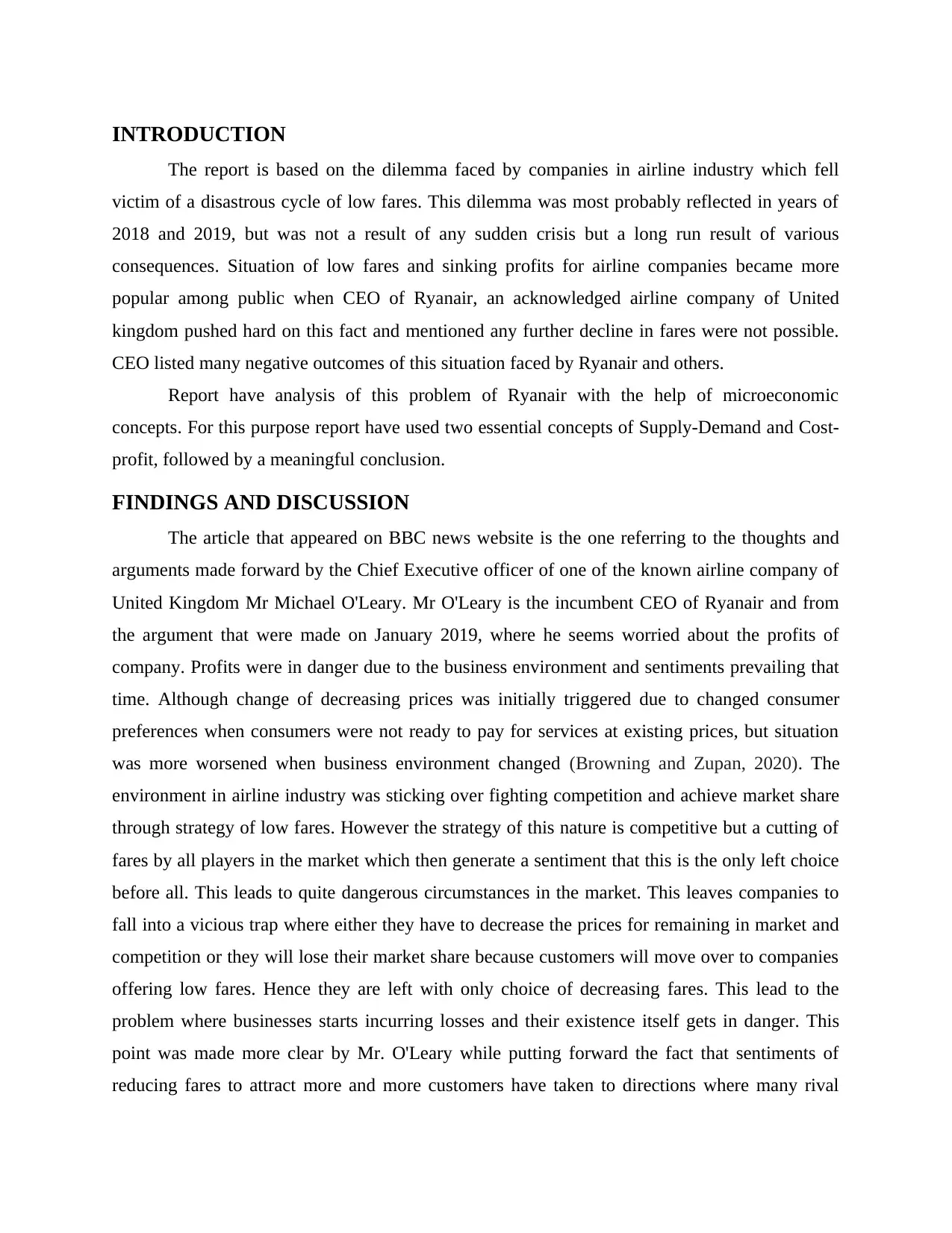
INTRODUCTION
The report is based on the dilemma faced by companies in airline industry which fell
victim of a disastrous cycle of low fares. This dilemma was most probably reflected in years of
2018 and 2019, but was not a result of any sudden crisis but a long run result of various
consequences. Situation of low fares and sinking profits for airline companies became more
popular among public when CEO of Ryanair, an acknowledged airline company of United
kingdom pushed hard on this fact and mentioned any further decline in fares were not possible.
CEO listed many negative outcomes of this situation faced by Ryanair and others.
Report have analysis of this problem of Ryanair with the help of microeconomic
concepts. For this purpose report have used two essential concepts of Supply-Demand and Cost-
profit, followed by a meaningful conclusion.
FINDINGS AND DISCUSSION
The article that appeared on BBC news website is the one referring to the thoughts and
arguments made forward by the Chief Executive officer of one of the known airline company of
United Kingdom Mr Michael O'Leary. Mr O'Leary is the incumbent CEO of Ryanair and from
the argument that were made on January 2019, where he seems worried about the profits of
company. Profits were in danger due to the business environment and sentiments prevailing that
time. Although change of decreasing prices was initially triggered due to changed consumer
preferences when consumers were not ready to pay for services at existing prices, but situation
was more worsened when business environment changed (Browning and Zupan, 2020). The
environment in airline industry was sticking over fighting competition and achieve market share
through strategy of low fares. However the strategy of this nature is competitive but a cutting of
fares by all players in the market which then generate a sentiment that this is the only left choice
before all. This leads to quite dangerous circumstances in the market. This leaves companies to
fall into a vicious trap where either they have to decrease the prices for remaining in market and
competition or they will lose their market share because customers will move over to companies
offering low fares. Hence they are left with only choice of decreasing fares. This lead to the
problem where businesses starts incurring losses and their existence itself gets in danger. This
point was made more clear by Mr. O'Leary while putting forward the fact that sentiments of
reducing fares to attract more and more customers have taken to directions where many rival
The report is based on the dilemma faced by companies in airline industry which fell
victim of a disastrous cycle of low fares. This dilemma was most probably reflected in years of
2018 and 2019, but was not a result of any sudden crisis but a long run result of various
consequences. Situation of low fares and sinking profits for airline companies became more
popular among public when CEO of Ryanair, an acknowledged airline company of United
kingdom pushed hard on this fact and mentioned any further decline in fares were not possible.
CEO listed many negative outcomes of this situation faced by Ryanair and others.
Report have analysis of this problem of Ryanair with the help of microeconomic
concepts. For this purpose report have used two essential concepts of Supply-Demand and Cost-
profit, followed by a meaningful conclusion.
FINDINGS AND DISCUSSION
The article that appeared on BBC news website is the one referring to the thoughts and
arguments made forward by the Chief Executive officer of one of the known airline company of
United Kingdom Mr Michael O'Leary. Mr O'Leary is the incumbent CEO of Ryanair and from
the argument that were made on January 2019, where he seems worried about the profits of
company. Profits were in danger due to the business environment and sentiments prevailing that
time. Although change of decreasing prices was initially triggered due to changed consumer
preferences when consumers were not ready to pay for services at existing prices, but situation
was more worsened when business environment changed (Browning and Zupan, 2020). The
environment in airline industry was sticking over fighting competition and achieve market share
through strategy of low fares. However the strategy of this nature is competitive but a cutting of
fares by all players in the market which then generate a sentiment that this is the only left choice
before all. This leads to quite dangerous circumstances in the market. This leaves companies to
fall into a vicious trap where either they have to decrease the prices for remaining in market and
competition or they will lose their market share because customers will move over to companies
offering low fares. Hence they are left with only choice of decreasing fares. This lead to the
problem where businesses starts incurring losses and their existence itself gets in danger. This
point was made more clear by Mr. O'Leary while putting forward the fact that sentiments of
reducing fares to attract more and more customers have taken to directions where many rival
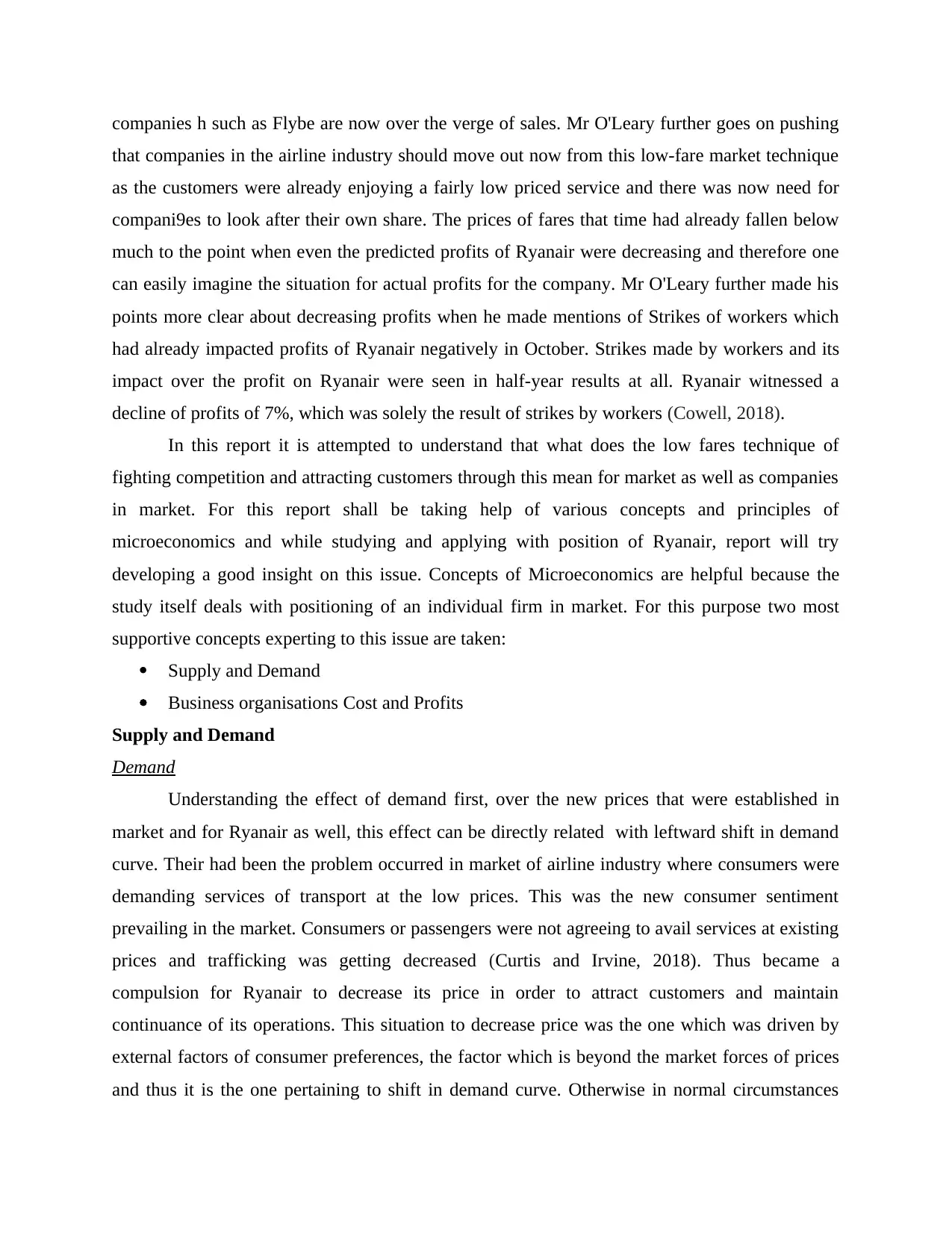
companies h such as Flybe are now over the verge of sales. Mr O'Leary further goes on pushing
that companies in the airline industry should move out now from this low-fare market technique
as the customers were already enjoying a fairly low priced service and there was now need for
compani9es to look after their own share. The prices of fares that time had already fallen below
much to the point when even the predicted profits of Ryanair were decreasing and therefore one
can easily imagine the situation for actual profits for the company. Mr O'Leary further made his
points more clear about decreasing profits when he made mentions of Strikes of workers which
had already impacted profits of Ryanair negatively in October. Strikes made by workers and its
impact over the profit on Ryanair were seen in half-year results at all. Ryanair witnessed a
decline of profits of 7%, which was solely the result of strikes by workers (Cowell, 2018).
In this report it is attempted to understand that what does the low fares technique of
fighting competition and attracting customers through this mean for market as well as companies
in market. For this report shall be taking help of various concepts and principles of
microeconomics and while studying and applying with position of Ryanair, report will try
developing a good insight on this issue. Concepts of Microeconomics are helpful because the
study itself deals with positioning of an individual firm in market. For this purpose two most
supportive concepts experting to this issue are taken:
Supply and Demand
Business organisations Cost and Profits
Supply and Demand
Demand
Understanding the effect of demand first, over the new prices that were established in
market and for Ryanair as well, this effect can be directly related with leftward shift in demand
curve. Their had been the problem occurred in market of airline industry where consumers were
demanding services of transport at the low prices. This was the new consumer sentiment
prevailing in the market. Consumers or passengers were not agreeing to avail services at existing
prices and trafficking was getting decreased (Curtis and Irvine, 2018). Thus became a
compulsion for Ryanair to decrease its price in order to attract customers and maintain
continuance of its operations. This situation to decrease price was the one which was driven by
external factors of consumer preferences, the factor which is beyond the market forces of prices
and thus it is the one pertaining to shift in demand curve. Otherwise in normal circumstances
that companies in the airline industry should move out now from this low-fare market technique
as the customers were already enjoying a fairly low priced service and there was now need for
compani9es to look after their own share. The prices of fares that time had already fallen below
much to the point when even the predicted profits of Ryanair were decreasing and therefore one
can easily imagine the situation for actual profits for the company. Mr O'Leary further made his
points more clear about decreasing profits when he made mentions of Strikes of workers which
had already impacted profits of Ryanair negatively in October. Strikes made by workers and its
impact over the profit on Ryanair were seen in half-year results at all. Ryanair witnessed a
decline of profits of 7%, which was solely the result of strikes by workers (Cowell, 2018).
In this report it is attempted to understand that what does the low fares technique of
fighting competition and attracting customers through this mean for market as well as companies
in market. For this report shall be taking help of various concepts and principles of
microeconomics and while studying and applying with position of Ryanair, report will try
developing a good insight on this issue. Concepts of Microeconomics are helpful because the
study itself deals with positioning of an individual firm in market. For this purpose two most
supportive concepts experting to this issue are taken:
Supply and Demand
Business organisations Cost and Profits
Supply and Demand
Demand
Understanding the effect of demand first, over the new prices that were established in
market and for Ryanair as well, this effect can be directly related with leftward shift in demand
curve. Their had been the problem occurred in market of airline industry where consumers were
demanding services of transport at the low prices. This was the new consumer sentiment
prevailing in the market. Consumers or passengers were not agreeing to avail services at existing
prices and trafficking was getting decreased (Curtis and Irvine, 2018). Thus became a
compulsion for Ryanair to decrease its price in order to attract customers and maintain
continuance of its operations. This situation to decrease price was the one which was driven by
external factors of consumer preferences, the factor which is beyond the market forces of prices
and thus it is the one pertaining to shift in demand curve. Otherwise in normal circumstances
⊘ This is a preview!⊘
Do you want full access?
Subscribe today to unlock all pages.

Trusted by 1+ million students worldwide
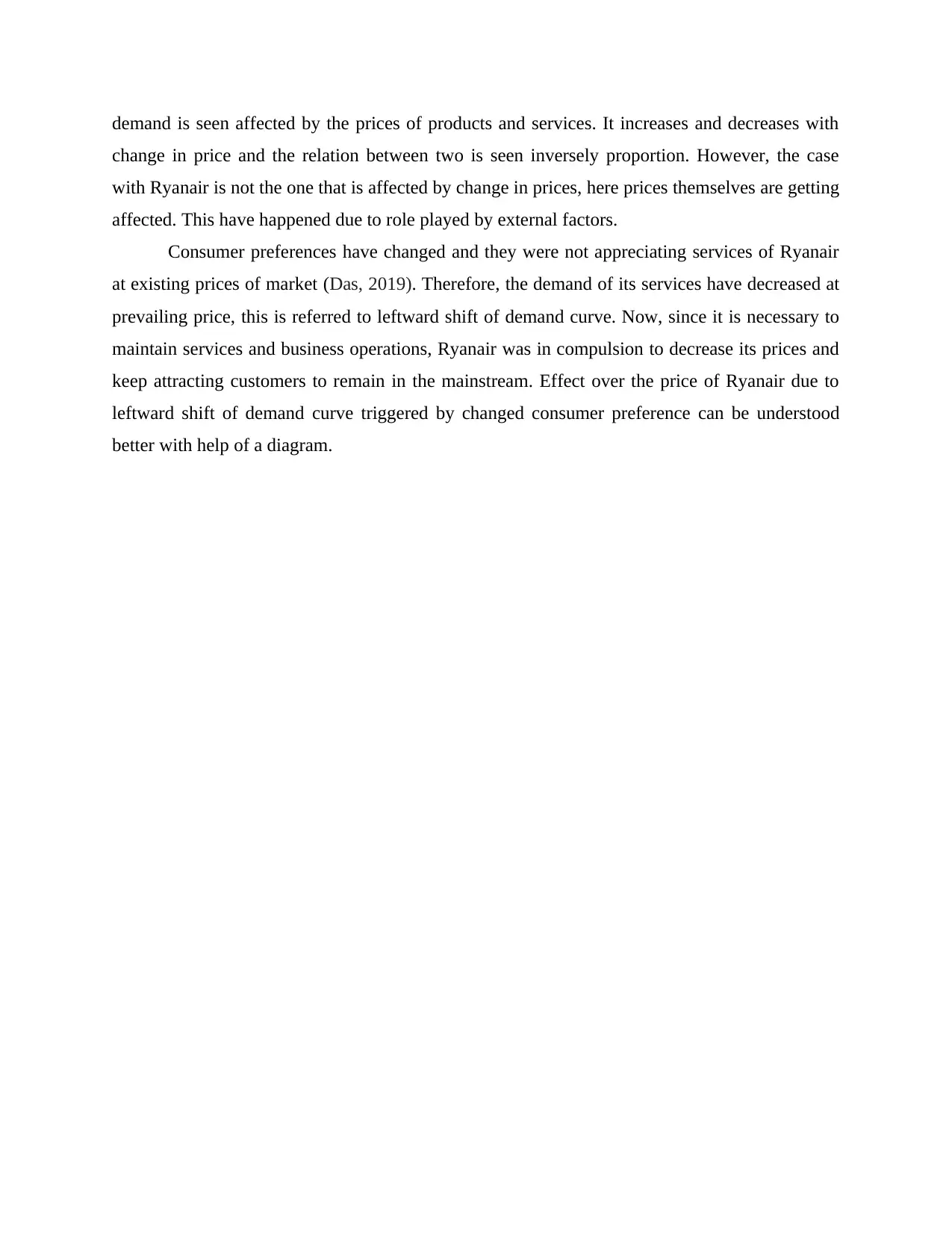
demand is seen affected by the prices of products and services. It increases and decreases with
change in price and the relation between two is seen inversely proportion. However, the case
with Ryanair is not the one that is affected by change in prices, here prices themselves are getting
affected. This have happened due to role played by external factors.
Consumer preferences have changed and they were not appreciating services of Ryanair
at existing prices of market (Das, 2019). Therefore, the demand of its services have decreased at
prevailing price, this is referred to leftward shift of demand curve. Now, since it is necessary to
maintain services and business operations, Ryanair was in compulsion to decrease its prices and
keep attracting customers to remain in the mainstream. Effect over the price of Ryanair due to
leftward shift of demand curve triggered by changed consumer preference can be understood
better with help of a diagram.
change in price and the relation between two is seen inversely proportion. However, the case
with Ryanair is not the one that is affected by change in prices, here prices themselves are getting
affected. This have happened due to role played by external factors.
Consumer preferences have changed and they were not appreciating services of Ryanair
at existing prices of market (Das, 2019). Therefore, the demand of its services have decreased at
prevailing price, this is referred to leftward shift of demand curve. Now, since it is necessary to
maintain services and business operations, Ryanair was in compulsion to decrease its prices and
keep attracting customers to remain in the mainstream. Effect over the price of Ryanair due to
leftward shift of demand curve triggered by changed consumer preference can be understood
better with help of a diagram.
Paraphrase This Document
Need a fresh take? Get an instant paraphrase of this document with our AI Paraphraser
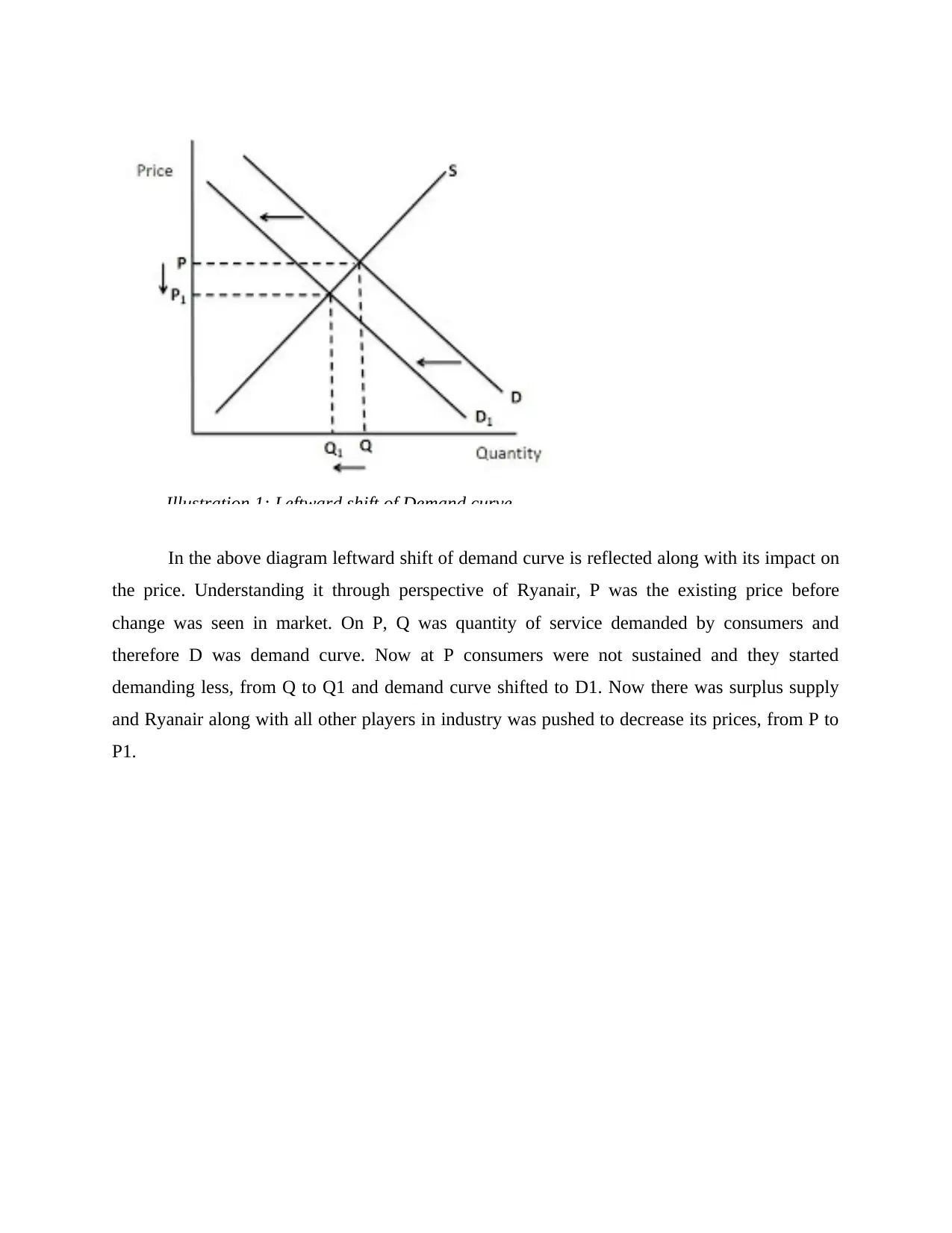
In the above diagram leftward shift of demand curve is reflected along with its impact on
the price. Understanding it through perspective of Ryanair, P was the existing price before
change was seen in market. On P, Q was quantity of service demanded by consumers and
therefore D was demand curve. Now at P consumers were not sustained and they started
demanding less, from Q to Q1 and demand curve shifted to D1. Now there was surplus supply
and Ryanair along with all other players in industry was pushed to decrease its prices, from P to
P1.
Illustration 1: Leftward shift of Demand curve
the price. Understanding it through perspective of Ryanair, P was the existing price before
change was seen in market. On P, Q was quantity of service demanded by consumers and
therefore D was demand curve. Now at P consumers were not sustained and they started
demanding less, from Q to Q1 and demand curve shifted to D1. Now there was surplus supply
and Ryanair along with all other players in industry was pushed to decrease its prices, from P to
P1.
Illustration 1: Leftward shift of Demand curve
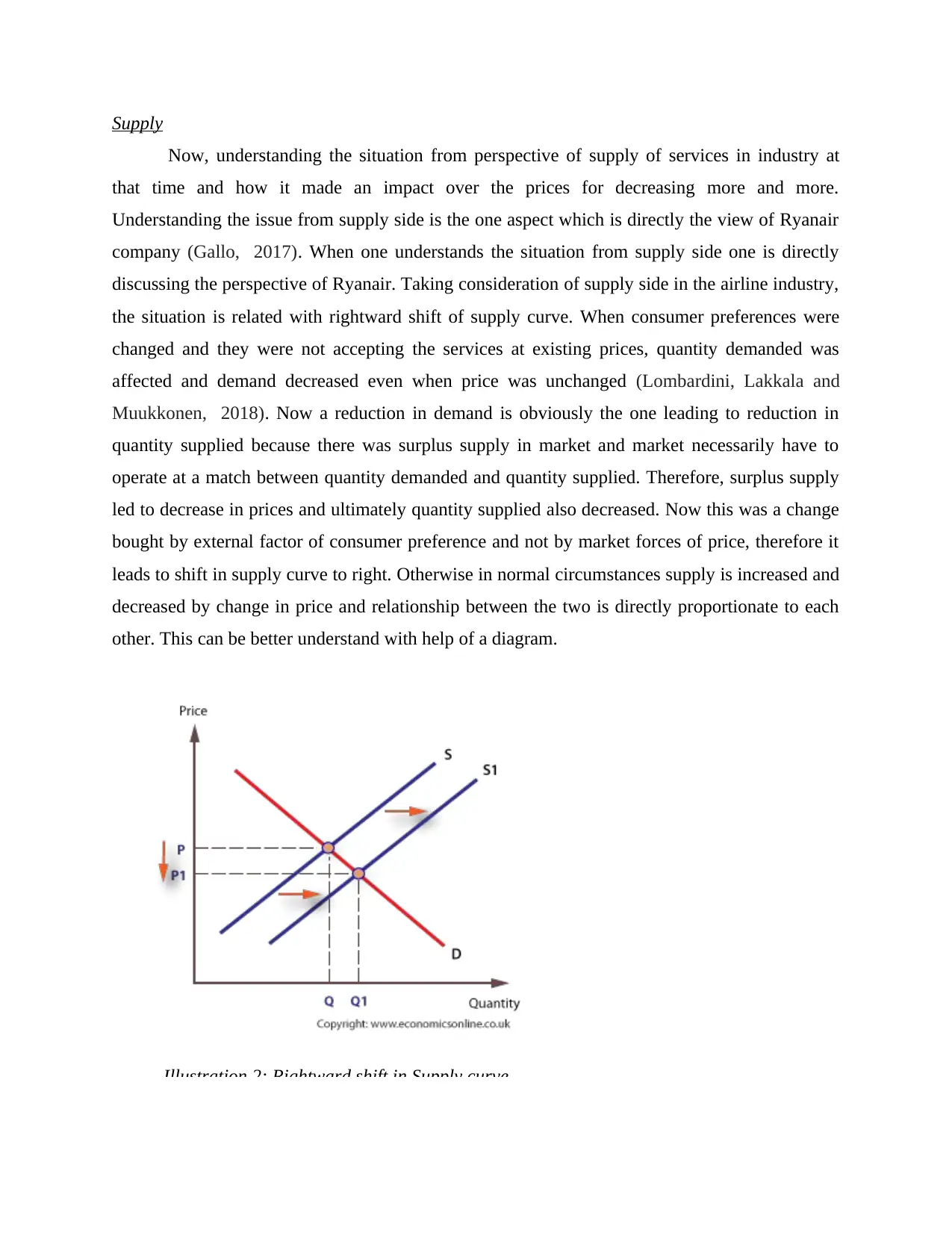
Supply
Now, understanding the situation from perspective of supply of services in industry at
that time and how it made an impact over the prices for decreasing more and more.
Understanding the issue from supply side is the one aspect which is directly the view of Ryanair
company (Gallo, 2017). When one understands the situation from supply side one is directly
discussing the perspective of Ryanair. Taking consideration of supply side in the airline industry,
the situation is related with rightward shift of supply curve. When consumer preferences were
changed and they were not accepting the services at existing prices, quantity demanded was
affected and demand decreased even when price was unchanged (Lombardini, Lakkala and
Muukkonen, 2018). Now a reduction in demand is obviously the one leading to reduction in
quantity supplied because there was surplus supply in market and market necessarily have to
operate at a match between quantity demanded and quantity supplied. Therefore, surplus supply
led to decrease in prices and ultimately quantity supplied also decreased. Now this was a change
bought by external factor of consumer preference and not by market forces of price, therefore it
leads to shift in supply curve to right. Otherwise in normal circumstances supply is increased and
decreased by change in price and relationship between the two is directly proportionate to each
other. This can be better understand with help of a diagram.
Illustration 2: Rightward shift in Supply curve
Now, understanding the situation from perspective of supply of services in industry at
that time and how it made an impact over the prices for decreasing more and more.
Understanding the issue from supply side is the one aspect which is directly the view of Ryanair
company (Gallo, 2017). When one understands the situation from supply side one is directly
discussing the perspective of Ryanair. Taking consideration of supply side in the airline industry,
the situation is related with rightward shift of supply curve. When consumer preferences were
changed and they were not accepting the services at existing prices, quantity demanded was
affected and demand decreased even when price was unchanged (Lombardini, Lakkala and
Muukkonen, 2018). Now a reduction in demand is obviously the one leading to reduction in
quantity supplied because there was surplus supply in market and market necessarily have to
operate at a match between quantity demanded and quantity supplied. Therefore, surplus supply
led to decrease in prices and ultimately quantity supplied also decreased. Now this was a change
bought by external factor of consumer preference and not by market forces of price, therefore it
leads to shift in supply curve to right. Otherwise in normal circumstances supply is increased and
decreased by change in price and relationship between the two is directly proportionate to each
other. This can be better understand with help of a diagram.
Illustration 2: Rightward shift in Supply curve
⊘ This is a preview!⊘
Do you want full access?
Subscribe today to unlock all pages.

Trusted by 1+ million students worldwide
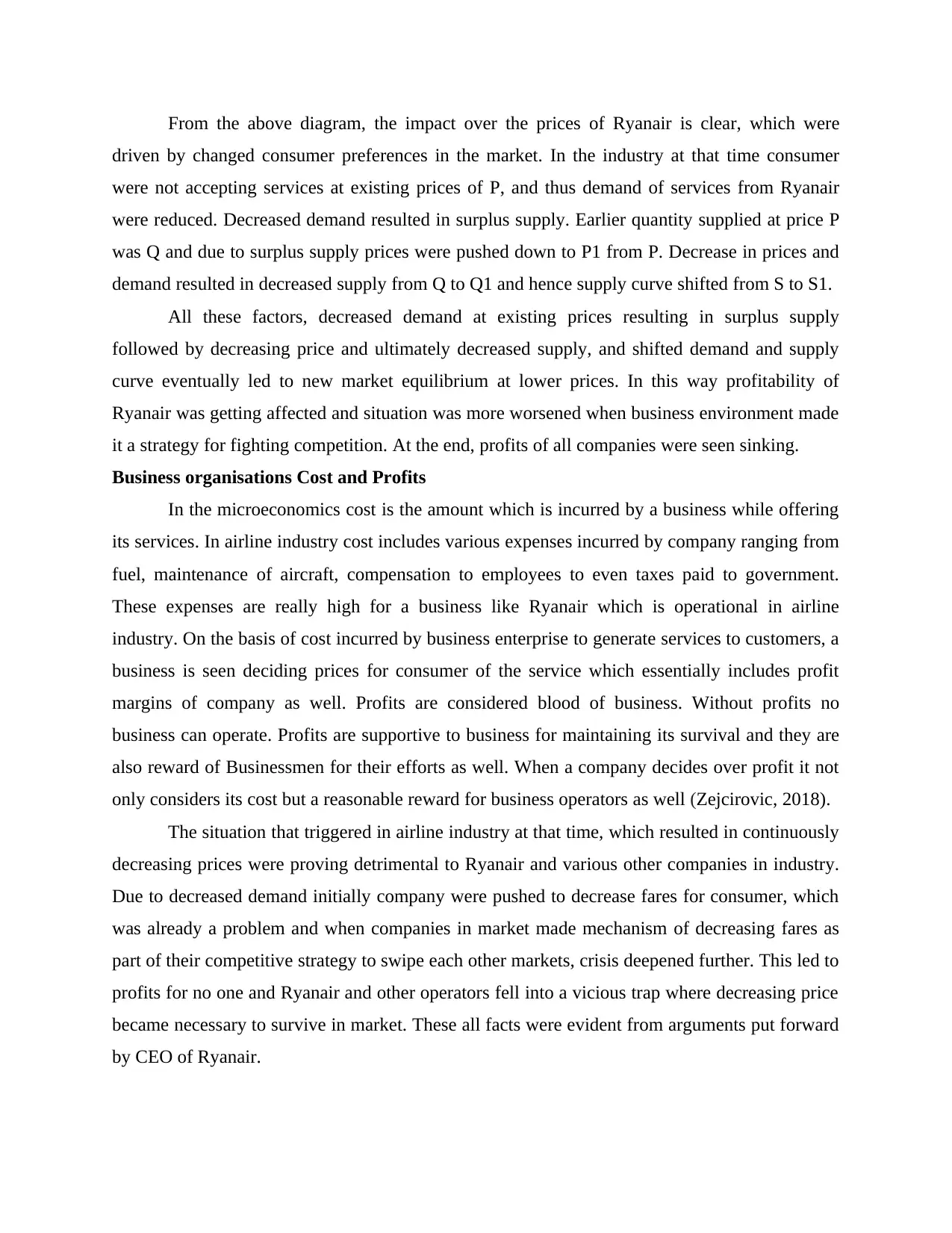
From the above diagram, the impact over the prices of Ryanair is clear, which were
driven by changed consumer preferences in the market. In the industry at that time consumer
were not accepting services at existing prices of P, and thus demand of services from Ryanair
were reduced. Decreased demand resulted in surplus supply. Earlier quantity supplied at price P
was Q and due to surplus supply prices were pushed down to P1 from P. Decrease in prices and
demand resulted in decreased supply from Q to Q1 and hence supply curve shifted from S to S1.
All these factors, decreased demand at existing prices resulting in surplus supply
followed by decreasing price and ultimately decreased supply, and shifted demand and supply
curve eventually led to new market equilibrium at lower prices. In this way profitability of
Ryanair was getting affected and situation was more worsened when business environment made
it a strategy for fighting competition. At the end, profits of all companies were seen sinking.
Business organisations Cost and Profits
In the microeconomics cost is the amount which is incurred by a business while offering
its services. In airline industry cost includes various expenses incurred by company ranging from
fuel, maintenance of aircraft, compensation to employees to even taxes paid to government.
These expenses are really high for a business like Ryanair which is operational in airline
industry. On the basis of cost incurred by business enterprise to generate services to customers, a
business is seen deciding prices for consumer of the service which essentially includes profit
margins of company as well. Profits are considered blood of business. Without profits no
business can operate. Profits are supportive to business for maintaining its survival and they are
also reward of Businessmen for their efforts as well. When a company decides over profit it not
only considers its cost but a reasonable reward for business operators as well (Zejcirovic, 2018).
The situation that triggered in airline industry at that time, which resulted in continuously
decreasing prices were proving detrimental to Ryanair and various other companies in industry.
Due to decreased demand initially company were pushed to decrease fares for consumer, which
was already a problem and when companies in market made mechanism of decreasing fares as
part of their competitive strategy to swipe each other markets, crisis deepened further. This led to
profits for no one and Ryanair and other operators fell into a vicious trap where decreasing price
became necessary to survive in market. These all facts were evident from arguments put forward
by CEO of Ryanair.
driven by changed consumer preferences in the market. In the industry at that time consumer
were not accepting services at existing prices of P, and thus demand of services from Ryanair
were reduced. Decreased demand resulted in surplus supply. Earlier quantity supplied at price P
was Q and due to surplus supply prices were pushed down to P1 from P. Decrease in prices and
demand resulted in decreased supply from Q to Q1 and hence supply curve shifted from S to S1.
All these factors, decreased demand at existing prices resulting in surplus supply
followed by decreasing price and ultimately decreased supply, and shifted demand and supply
curve eventually led to new market equilibrium at lower prices. In this way profitability of
Ryanair was getting affected and situation was more worsened when business environment made
it a strategy for fighting competition. At the end, profits of all companies were seen sinking.
Business organisations Cost and Profits
In the microeconomics cost is the amount which is incurred by a business while offering
its services. In airline industry cost includes various expenses incurred by company ranging from
fuel, maintenance of aircraft, compensation to employees to even taxes paid to government.
These expenses are really high for a business like Ryanair which is operational in airline
industry. On the basis of cost incurred by business enterprise to generate services to customers, a
business is seen deciding prices for consumer of the service which essentially includes profit
margins of company as well. Profits are considered blood of business. Without profits no
business can operate. Profits are supportive to business for maintaining its survival and they are
also reward of Businessmen for their efforts as well. When a company decides over profit it not
only considers its cost but a reasonable reward for business operators as well (Zejcirovic, 2018).
The situation that triggered in airline industry at that time, which resulted in continuously
decreasing prices were proving detrimental to Ryanair and various other companies in industry.
Due to decreased demand initially company were pushed to decrease fares for consumer, which
was already a problem and when companies in market made mechanism of decreasing fares as
part of their competitive strategy to swipe each other markets, crisis deepened further. This led to
profits for no one and Ryanair and other operators fell into a vicious trap where decreasing price
became necessary to survive in market. These all facts were evident from arguments put forward
by CEO of Ryanair.
Paraphrase This Document
Need a fresh take? Get an instant paraphrase of this document with our AI Paraphraser
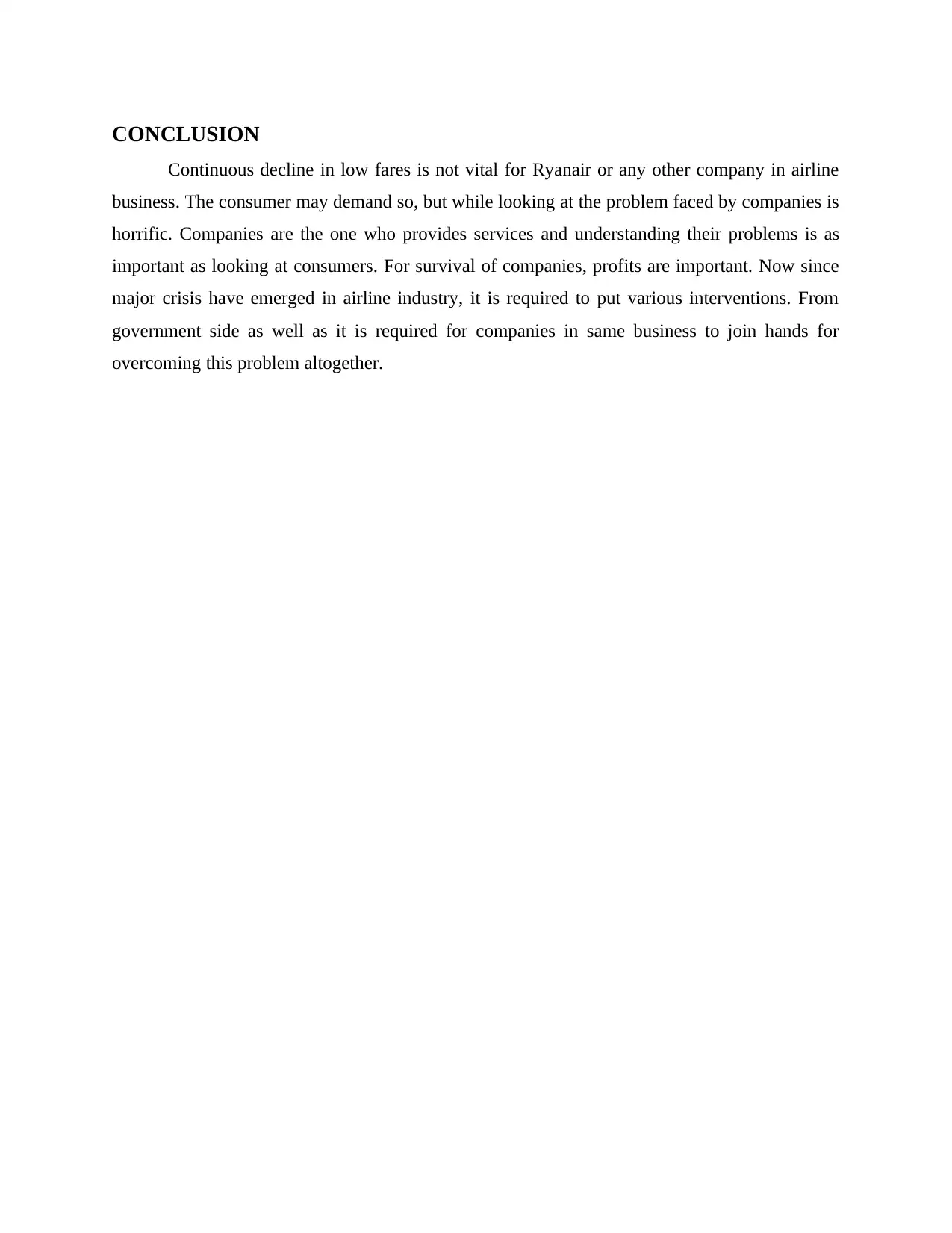
CONCLUSION
Continuous decline in low fares is not vital for Ryanair or any other company in airline
business. The consumer may demand so, but while looking at the problem faced by companies is
horrific. Companies are the one who provides services and understanding their problems is as
important as looking at consumers. For survival of companies, profits are important. Now since
major crisis have emerged in airline industry, it is required to put various interventions. From
government side as well as it is required for companies in same business to join hands for
overcoming this problem altogether.
Continuous decline in low fares is not vital for Ryanair or any other company in airline
business. The consumer may demand so, but while looking at the problem faced by companies is
horrific. Companies are the one who provides services and understanding their problems is as
important as looking at consumers. For survival of companies, profits are important. Now since
major crisis have emerged in airline industry, it is required to put various interventions. From
government side as well as it is required for companies in same business to join hands for
overcoming this problem altogether.
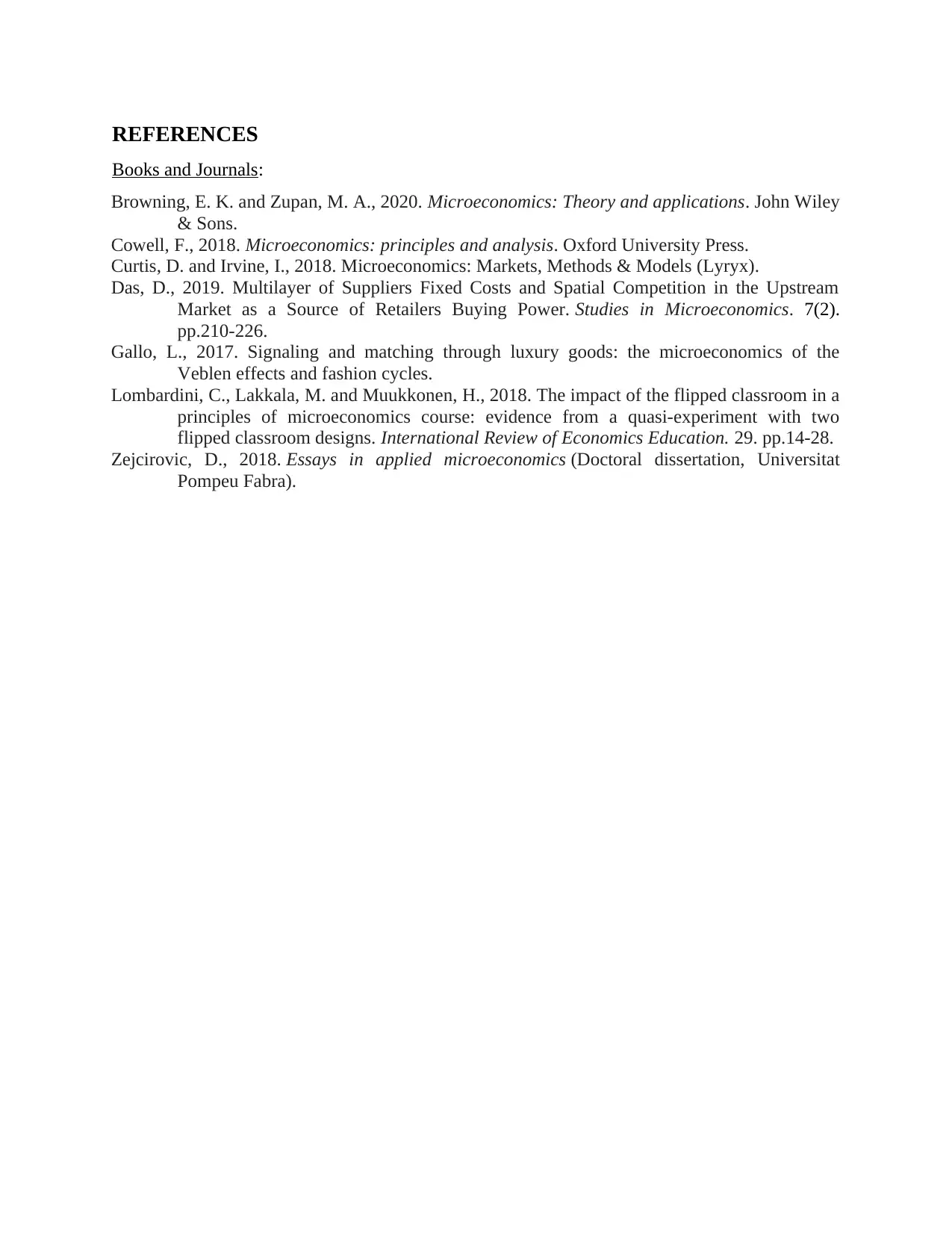
REFERENCES
Books and Journals:
Browning, E. K. and Zupan, M. A., 2020. Microeconomics: Theory and applications. John Wiley
& Sons.
Cowell, F., 2018. Microeconomics: principles and analysis. Oxford University Press.
Curtis, D. and Irvine, I., 2018. Microeconomics: Markets, Methods & Models (Lyryx).
Das, D., 2019. Multilayer of Suppliers Fixed Costs and Spatial Competition in the Upstream
Market as a Source of Retailers Buying Power. Studies in Microeconomics. 7(2).
pp.210-226.
Gallo, L., 2017. Signaling and matching through luxury goods: the microeconomics of the
Veblen effects and fashion cycles.
Lombardini, C., Lakkala, M. and Muukkonen, H., 2018. The impact of the flipped classroom in a
principles of microeconomics course: evidence from a quasi-experiment with two
flipped classroom designs. International Review of Economics Education. 29. pp.14-28.
Zejcirovic, D., 2018. Essays in applied microeconomics (Doctoral dissertation, Universitat
Pompeu Fabra).
Books and Journals:
Browning, E. K. and Zupan, M. A., 2020. Microeconomics: Theory and applications. John Wiley
& Sons.
Cowell, F., 2018. Microeconomics: principles and analysis. Oxford University Press.
Curtis, D. and Irvine, I., 2018. Microeconomics: Markets, Methods & Models (Lyryx).
Das, D., 2019. Multilayer of Suppliers Fixed Costs and Spatial Competition in the Upstream
Market as a Source of Retailers Buying Power. Studies in Microeconomics. 7(2).
pp.210-226.
Gallo, L., 2017. Signaling and matching through luxury goods: the microeconomics of the
Veblen effects and fashion cycles.
Lombardini, C., Lakkala, M. and Muukkonen, H., 2018. The impact of the flipped classroom in a
principles of microeconomics course: evidence from a quasi-experiment with two
flipped classroom designs. International Review of Economics Education. 29. pp.14-28.
Zejcirovic, D., 2018. Essays in applied microeconomics (Doctoral dissertation, Universitat
Pompeu Fabra).
⊘ This is a preview!⊘
Do you want full access?
Subscribe today to unlock all pages.

Trusted by 1+ million students worldwide
1 out of 9
Related Documents
Your All-in-One AI-Powered Toolkit for Academic Success.
+13062052269
info@desklib.com
Available 24*7 on WhatsApp / Email
![[object Object]](/_next/static/media/star-bottom.7253800d.svg)
Unlock your academic potential
Copyright © 2020–2025 A2Z Services. All Rights Reserved. Developed and managed by ZUCOL.





